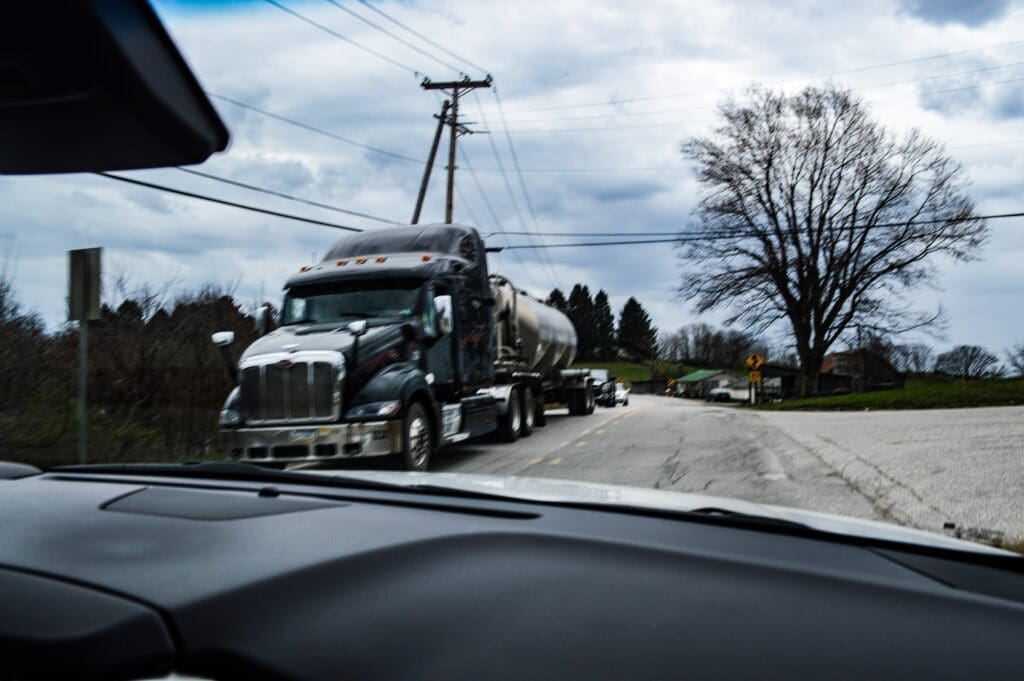When officials of the state Department of Transportation developed the amounts of funds that would be distributed to the 10 districts in the Division of Highways for the last year, District 9 was first with 17.25 percent of nearly $1 billion allocated for new projects and core maintenance, and District 6 was last with 8.34 percent.
District 9 includes Fayette, Greenbrier, Monroe, Nicholas, and Summers counties, and District 6 consists of Tyler, Wetzel, Marshall, Ohio, Brooke, and Hancock counties. There is very little gas or oil drilling that takes place within District 9, and the most intense activity continues to take place in District 6, where both the Marcellus and Utica shale plays available to the harvesting companies.
That’s why John Gruzinksas, one of three Marshall County commissioners, is puzzled.
“The way the state funds road maintenance makes no sense to us in the Northern Panhandle, and I don’t believe it’s ever made sense,” the commissioner said. “I am not sure how the people in Charleston can justify it with the governor saying himself that we have it the worst in Marshall County. ‘The worst in the state.’ Those are his words, and they speak volumes to us in Marshall County.

“The officials from Charleston have gone out on our roads, so they have seen them for themselves, and so we’re hoping whatever formula they use down there is changed to appropriately reflect the needs in our county and throughout the Northern Panhandle,” he continued. “Something has to happen; it’s that simple. Marshall County is the most drilled county for both gas and oil, and Marshall County also produces the most coal in the state these days, so the way the funding is right now isn’t fair at all to the people of Marshall County. It leaves a lot of people scratching their heads.”
What’s worse is the fact that Marshall County is very rural outside of Glen Dale, Moundsville, and Cameron, and along with the water and sand trucks that continually run the roads to more than 100 well pads, Williams Energy has received more than five “super loads” to their ever-growing Oak Grove processing facility.
Coupled with the fact that, before the arrival of the gas and oil industries, the weight limit on secondary roads was 43,000 pounds.
“Yeah, but the state people changed that limit to 78,000 pounds with a stroke of a pen,” Gruzinksas said. “And how do we know those trucks aren’t above 78,000 pounds? Who’s the gatekeeper on that?
“When I was serving as sheriff of Marshall County and something went wrong, it was my fault, and I accepted that,” he explained. “In that type of position, you have to accept the responsibility and you have to lead, so hopefully those folks will understand that and do their jobs.”

Thanks to additional funding allocated to the northern counties, more than 30 of the nearly 700 roadway slips have been repaired by District 6 employees thus far.
“And some of the worst slips have been repaired, so that’s the good news. The bad news is that there are more than 650 throughout the county,” Gruzinksas reported. “They have done some work on Roberts Ridge and Sally’s Backbone, and a lot of the slips that have been repaired were along U.S. 250. I’m not sure how many have been fixed, but there are several really bad ones along that road.
“The one on Sally’s Backbone was one of the worst ones we had in the county because it actually was eating over the double yellow lines, and school buses were having issues,” he continued. “That was the one that sparked a lot of attention and led to the emergency declaration in Marshall County. That slip lit the fuse.”
That does not mean, Gruzinksas warned, that all the school children on the bright yellow buses are completely safe while traveling to and from their schools.

“Despite the work that has been performed to this point, the condition of the secondary roads remains a critical issue for the people of this county,” Gruzinksas insisted. “Those kids are not all safe, and you do have to give a lot of credit to those bus drivers because they are the ones who are entrusted with the safety of those kids, and they are the ones who are able to maneuver these vehicles around the skips and around all of the potholes.
“Without more attention, we will get to the point to where we have detours, and that would be a very scary situation for our residents,” he said. “In many cases, there are alternatives, and those roads have been used for the detours, but we have so many that are still occurring that it makes you wonder when this is going to stop. When will the state start preventing us from losing our roads over hillsides?”
The Marshall County Commission declared a state of emergency in April because of the condition of the county’s secondary roads, and Gruzinksas does not believe it is time to rescind that proclamation.
“It will go away once it’s not an emergency anymore,” the commissioner said. “And that emergency is not over in Marshall County because we still have a lot of issues around the county concerning our roads.
“We took a beating for so long, and it took a long time for us to get into this situation, so naturally it’s going to take some time to get us out of it. I do have to give a lot of credit to our DOH staff here in District 6 because they have worked very hard to get several projects completed,” he said. “But there’s still a lot of work that needs done before I can say that everyone is safe out there.”




